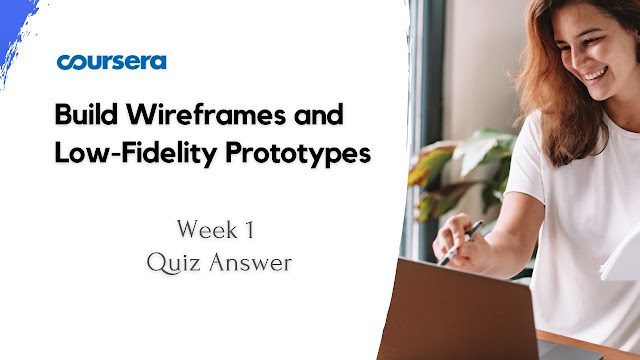Build Wireframes and Low-Fidelity Prototypes Week 1 Quiz Answer
In this article i am gone to share Build Wireframes and Low-Fidelity Prototypes Week 1 Quiz Answer with you..
Build Wireframes and Low-Fidelity Prototypes Week 1 Quiz Answer
Also visit this link: Build Wireframes and Low-Fidelity Prototypes Week 3 Quiz Answer
Optional – Test your knowledge of prior concepts Quiz Answers
Question 1) What are some key benefits of considering accessibility in UX design? Select all that apply.
- Creates solutions that often help everyone
- Ensures underrepresented and excluded groups are taken into account
- Addresses societal structures and products rather than a person’s ability
Question 2) Which phase of the design sprint helps the team find solutions to build on?
- Ideate
- Test
- Decide
- Understand
- Prototype
Question 3) What can a researcher learn when they properly empathize with users during user research?
- The hopes, dreams, and assumptions of their users
- The opinions, feelings, and biases of their users
- The wants, desires, and fears of their users
- The needs, behaviors, and motivations of their users
Question 4) Which of the following are examples of pain points? Select all that apply.
- Completing the checkout process for a food delivery app
- Being asked to submit credit card information when no payment is required
- Receiving the same response to three different questions from an automated chatbot
- Struggling to interact with a button on a mobile app’s homepage because it’s extremely small
Question 5) Which of the following statements about user personas is true?
- Personas can help identify patterns of behavior in users.
- Personas are modeled after the characteristics of the UX designer.
- UX designers should avoid creating backstories for personas
- A persona is a real user who provides real reviews on a product.
Question 6) Which of these user stories includes a type of user, an action, and a benefit?
- As a scientist, I want access to my colleagues’ published research.
- I want a bookshelf so I have somewhere to store my book collection.
- As a chef, I want access to the freshest ingredients and the highest-quality cooking utensils.
- As a yoga instructor, I want to create a consistent class schedule so that my clients know how to confidently plan their weekly exercise.
Question 7) Fill in the blank: Designing products with accessibility and inclusivity in mind ensures that you _____.
- create a different solution for every single user.
- focus on creating one solution for as many people as possible
- create an identical experience for all users
- include solutions that benefit specific individuals, which improves the user experience for all users.
Question 8) Which of the following is a complete problem statement?
- Angelo needs a toolbox and shingles to fix the leak in their roof.
- Akiko is a construction consultant who is building a skyscraper.
- Hakim is an accountant who needs to collect expense reports from their coworkers.
- Bella is a dance choreographer who needs to create a practice video because some of their students have school during the day and can’t attend lessons in person.
Question 9) Identify the steps of the ideation process in the correct order.
- Documenting ideas, brainstorming, focusing on quantity, questioning obvious solutions, gathering a diverse team, and evaluating the ideas.
- Brainstorming, documenting ideas, focusing on quantity, gathering a diverse team, questioning obvious solutions, and evaluating the ideas.
- Gathering a diverse team, brainstorming, documenting ideas, questioning obvious solutions, focusing on quantity, and evaluating the ideas.
Question 10) You’re a UX designer working on a gaming app in a competitive market space. You want to figure out what your competitors’ strengths and weaknesses are, and how to create a better product. What should you do?
- Create a marketing plan
- Conduct a competitive audit
- Contact each company directly
- Conduct informal research online
Test your knowledge of storyboards
Question 1) What are the key elements of a storyboard? Select all that apply.
- Narrative
- Plot
- Scene
- Character
- Theme
Question 2) Which of the following scenarios would be most appropriate to use a big picture storyboard?
- You create a tool that connects auto mechanics with local auto parts stores to check product availability in real-time. You want to test the app for possible connection issues.
- You start the design process for a new grocery delivery app. You want to pitch some ideas to the team about how the user could use it and benefit from it.
- You create a new homepage for a news site. You need to show the details of the product and what happens during each step of the user experience.
- This scenario would use a big picture storyboard because you’re focusing on how people will use the product throughout their day, and why that product will be useful.
Test your knowledge of design fidelity
Question 1) Fill in the blank: Wireframes establish the basic _____ of a page and serve as an outline of a digital experience.
- text
- functional specifications
- structure
- images
Question 2) Which of the design fidelity types would you use if you need to get ideas out quickly while leaving room open for exploration?
- Medium-fidelity design
- High-fidelity design
- Low-fidelity design
Question 3) Identify characteristics of a low-fidelity (lo-fi) design. Select all that apply.
- Low-fi designs use simple shapes and lines
- Lo-fi designs include graphics and images
- Low-fi designs are often used to get ideas out quickly.
- Lo-fi designs are highly refined and polished

